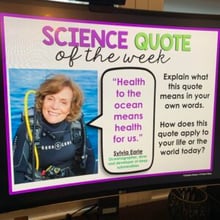Renewable Energy Resources Activities for
Middle School Science
The resources below will provide students a comprehensive understanding of renewable energy resources. All of the following lessons are also included in the Kesler Science Membership.
The Renewable Energy Resources 5E Lesson includes materials for every "E" phase, including the Renewable Energy Resources Station Lab for Exploration and an interactive PowerPoint with digital INB templates for Explanation.
The lesson also includes introduction materials for Engagement, student-choice project ideas for Elaboration, and assessments for Evaluation.
After completing the Renewable Energy Resources 5E Lesson, students will be able to research and debate the advantages and disadvantages of using biomass, wind, hydropower, geothermal, and solar resources.
The Renewable Energy Resources Inquiry Lab is a hands-on activity that is differentiated for advanced, on-level, and modified middle school students.
Students will use the energy resource cards to research various forms of nonrenewable and renewable resources.
The Renewable Energy Resources Inquiry Lab includes a brief reading passage, comprehension checks, hands-on activities, reflection questions, and a CER conclusion.
Renewable Energy Resources Classroom Experiences
Create a powerful student experience to help solidify students' understanding about renewable energy resources. The following experience is also included in the Kesler Science Membership.
Escape Rooms
The Energy Escape Room is an immersive experience for your students. It allows them to demonstrate their knowledge of renewable and nonrenewable energy in a fun and engaging format.
Students must use what they have learned to apply scientific principles to design a method for monitoring and minimizing a human impact on the environment. They will construct an argument supported by evidence for how increases in human population and per-capita consumption of natural resources impact Earth’s systems, and will research and discuss the advantages and disadvantages of using coal, oil, natural gas, nuclear power, biomass, wind, hydropower, geothermal, and solar resources. They will also need to design a logical plan to manage energy resources in the home, school, or community to complete the escape room.
Year-Round Resources
These year-round activities will increase your students' understanding of many middle school science topics. All of these activities are also included in the Kesler Science Membership.
Visual Data & Graphing
You're not alone if your students struggle with understanding graphs, charts, and tables. It's a skill that takes an enormous amount of practice. This resource will help students build a strong foundation in analyzing data and creating their own data visualizations.
Bell Ringers and Warm-Ups
These middle school science bell ringers are an excellent way to engage your students as soon as they walk into your classroom. This comprehensive FULL YEAR resource includes everything you need to start off each science class with an interesting warm-up activity.
Review Board Games
Each game board has been carefully designed to keep students engaged. There are 10 different action spaces on each board and dozens of question cards. All of the actions are related to science concepts and keep the students motivated throughout the game.
Each game is ready to play. Simply print out the board and the cards and let the students enjoy reviewing nine different units.
Essential Questions and Standards
Below are the essential questions and standards associated with the lessons and activities included in the renewable energy resources unit. This topic is only one of more than 100 middle school science topics included in the Kesler Science Membership.
-
What are the advantages and disadvantages of renewable energy sources?
-
How can my research findings be presented in a debate format?
-
MS ESS3-3 - Apply scientific principles to design a method for monitoring and minimizing a human impact on the environment
-
MS ESS3-4 - Construct an argument supported by evidence for how increases in human population and per-capita consumption of natural resources impact Earth’s systems
-
TEKS Science 6.7 A - Research and discuss the advantages and disadvantages of using coal, oil, natural gas, nuclear power, biomass, wind, hydropower, geothermal, and solar resources
Kesler Science Membership
Imagine never having to search for another middle school science lesson again. The membership gives you access to ALL of the Kesler Science products in one place (Yes, including everything above).
Say goodbye to long hours of lesson prep.


